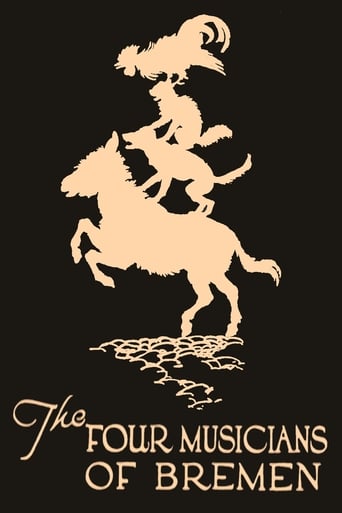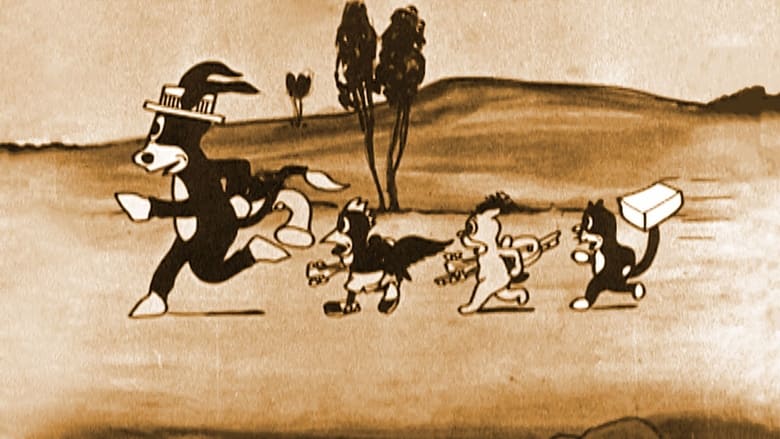

The Four Musicians of Bremen (1922)
Four animal musicians consisting of a Horse, Cat, Dog, & Rooster set out on their own quest to try to find some fame by playing their own music. Unfortunitly every where they go, trouble always occurs whether they are being chased by town folk, a sword fish, or being attacked by an army.
Watch Trailer
Cast


Reviews
An absolute waste of money
It’s fine. It's literally the definition of a fine movie. You’ve seen it before, you know every beat and outcome before the characters even do. Only question is how much escapism you’re looking for.
It is neither dumb nor smart enough to be fun, and spends way too much time with its boring human characters.
It’s sentimental, ridiculously long and only occasionally funny
"The Four Musicians of Bremen" is a 7-minute cartoon from 1922. so this one is approaching its 100th anniversary. As all of Walt Disney's very early work, it is a black-and-white silent film and he made several films based on the works of the Brothers Grimm. But with this one here, i also struggle to really see a connection to the fairy tale. It is not a convincing adaptation at all I must say. The fun and animation are okay for the early 20s, but the attempt to make it more popular with the fairy tale title is something I cannot approve of. The only reason why I don't give this one an even lower rating is because it is really very early from Disney's career and he was only 20 or 21 when he made it. I don't recommend the watch. Thumbs down. Laughogram doesn't fit at all as this was never a funny watch.
According to the IMDb list of Walt Disney's directorial achievements, this was the second earliest animated short he ever made (the first being Little Red Riding Hood). In this Laugh-O-Gram, we see four animals running from bricks being thrown after them by humans. The last of them, a cat, keeps appearing and disappearing at various points in this sequence. They stop at a river where three of them play music while the cat tries to catch a fish that walks out of the river and jumps away each time the cat tries to hit him with a board. I'll stop there and say that was pretty amusing as was a later sequence where some human men shoot cannon balls at the house the four animals are staying with the cat pulling a Felix and using his tail to hit one of those balls from the roof and then riding on another of them (or was it the same one? I can't remember). Pretty primitive but worth a look for anyone curious about the legendary Disney's earliest works.
Okay, this cartoon is a bit on the dull side and bore few signs of future greatness--I admit it. However, compared with other cartoons of the era, it's pretty good--especially in the animation quality. Apart from having backgrounds that keep repeating themselves again and again (a cheap technique that was later often used by Hanna-Barbera), it was top-notch work. The problem to is that the script was pretty weak and wasn't all that funny of interesting. Sadly, interesting scripts generally didn't materialize in cartoons until much later. Also, this toon bore no real resemblance to the classic story of the four animals aching to become musicians...and that's a shame because it would have beat this film.
"The Four Musicians of Bremen" is one of the very earliest Walt Disney cartoons, made at his first animation studio in Kansas City, Missouri. The Kansas City movies (all of them silent) are the only Disney cartoons that were actually drawn and animated by Walt Disney himself. Beginning with his Alice in Cartoonland series (created by Harman & Ising) and Mickey Mouse (created, drawn and animated by Ub Iwerks), all of the Disney studio's films were actually created by someone other than Uncle Walt himself. The Kansas City Disneys make it painfully obvious that Walt Disney's skills as a cartoonist, draughtsman and animator were extremely poor (even by the standards of 1920s animation). Disney wisely passed those jobs to craftsmen like Ub Iwerks and Hugh Harman. After relocating his studio from Kansas City to California, Disney confined his own efforts to the front office as a producer and administrator ... where he had considerable talents indeed."The Four Musicians of Bremen", like most of the Kansas City Disneys, is based on a European folktale ... in this case, the one about the four animals of Bremen (led by a donkey) who decide to "sing" but who have terrible voices. The cartoon is quite faithful to the original story, although slightly jazzed up for American audiences of the 1920s. Since the raucous animal noises made by the "musicians" are crucial to the plot (and to the comedy), it's unfortunate that this is a silent movie.Wherever possible here (and in all his Kansas City films), Disney resorts to "lazy" animation. At the climax of "The Four Musicians of Bremen", a swarm of bees chase four soldiers, who run together in a cluster (as if they were all glued to each other) so that they can be animated as a single unit (with repeating animation cels) rather than as distinct characters. The bees keep stinging the soldier in the centre of the cluster, who keeps jumping out of the group and then jumping back in again. Because the soldiers at the edge of the cluster never get stung, they never move away from the cluster ... and Disney can keep cycling the same animation cels for the entire sequence. It would be more believable (and funnier) if the bees stung each one of the soldiers in turn, but then the soldiers at the edge of the cluster would have to move individually ... which would be more expensive to animate. I find this sort of cheapjack animation very annoying: it's something that Disney moved away from very quickly, yet this "lazy" animation technique turned up again almost forty years later in the "Flintstones" cartoons. While I was watching "The Four Musicians of Bremen", I kept expecting to see the bees chase the soldiers past one tree ... the same tree, over and over and over. You know the tree I mean: the one that shows up in the background of every bottom-of-the-barrel cartoon (including the "Flintstones") when the characters pass the same tree every three seconds."The Four Musicians of Bremen" is interesting as an early example of Walt Disney's work - one of the very few examples of his OWN work - but it's not very funny and it certainly isn't attractive to look at.

